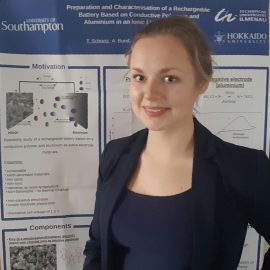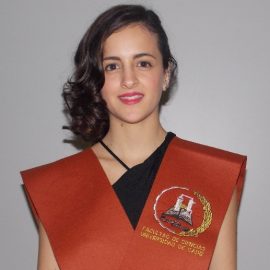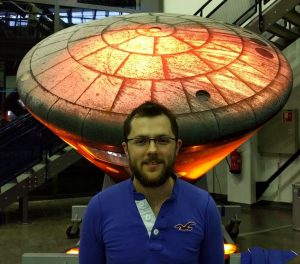|
Construction and characterization of rechargeable poly (3, 4-ethlenedioxythiophene)-aluminium batteries in ionic liquids
 Theresa Schoetz Theresa Schoetz
I am iPhD student within Engineering and the Environment at the University of Southampton. My research interests are related to the electrochemistry of energy storage materials and systems like batteries and capacitors. My PhD topic refers to the preparation and characterization of a rechargeable conductive polymer aluminum battery in ionic liquids.
I received my Bachelor of Engineering in Chemical Engineering at the BTU Cottbus-Senftenberg University of Technology (Germany) in 2013. In my master studies I focused on Electrochemistry and Electroplating and passed my Master of Science at the Technische Universität Ilmenau (Germany) in 2016.
During my studies I was private tutor for physics and mathematics and worked as working student at AREVA GmbH in Erlangen (Germany) on several electrolysis projects. Furthermore, I was employed as research assistant at Technische Universität Ilmenau on the electrodeposition and characterization of conductive polymers.
Especially my internship at the University of Salento in Lecce (Italy) on cathode materials of conductive polymers doped with metal nanoparticles and my master thesis at the Hokkaido University in Sapporo (Japan), where I studied the feasibility of a rechargeable aluminum- conductive polymer battery in ionic liquids, are important milestones in my scientific career.
Project Funders: Lloyds Register
Project Details: Energy storage technologies are in high demand for renewable energy systems such as photovoltaics, wind and tidal powers. Earth-abundant and low cost materials are preferred to ensure continuous supply to construct rechargeable and environmentally sustainable batteries. This project proposes a non-aqueous secondary battery based on aluminium metal and a conductive polymer, poly-(3,4-ethylenedioxythiophene) (PEDOT), as the negative and positive electrodes, respectively . The advantages of this system are: high specific energy density, due to the low weight of both aluminium and PEDOT, guaranteed availability of materials and the potential to compete with Li-ion systems for mobile or automotive applications. The first studies of this novel system, comprising half-cells test and galvanostatic charge and discharge cycles have shown reversibility and high specific energy density (max 230 W h kg-1). |
Integrated biorefinery products from wastes and residues
 Maria Ramos Suarez Maria Ramos Suarez
I did my Bachelor’s and Master’s degree in Chemical Engineering at The University of Cadiz (UCA), Spain, and specialised in bioprocess engineering. I also spent my 3rd year at the University of Manchester (UoM). I collaborated with the Analysis and Design of Processes with Supercritical Fluids group (UCA) in two different projects; one about phenolics extraction from mango leaves and the other about biodiesel production under supercritical conditions. During the summer break of my master’s degree I did a research internship within the Biorefinery Engineering group (UoM) on solid state fermentation. Later on, I did my dissertation on bioethanol production from sunflower stalks using ionic liquids (UoM/UCA).
My research interests cover biorefineries, bioprocessing, waste management/recycling and waste water treatment.
Currently, I am working on Integrated Biorefinery Products from Wastes and Residues, a project sponsored by Fiberight Ltd. This project will focus on the improvement of the Fiberight process downstream for biogas and/or bioethanol production.
Project Funders: Fiberight
Project Details: There is growing awareness of the need to maximise carbon recycle as an alternative to utilising virgin agricultural and forestry biomass sources as the starting point for biorefinery operations. Equally, for biorefineries to succeed they must develop to satisfy bulk product markets rather than concentrating on specialist high-value materials. The current research will contribute to the development of a ‘dirty’ biorefinery concept in which large-scale fermentation processes are not dependent on strict aseptic culture techniques. A substantial body of work has already been carried out within the research group to develop a biorefinery sugar platform using fibre recovered from municipal solid waste (MSW). The project will consider how this starting material can be used as the basis for an integrated biorefinery through enhanced understanding of interactions between processes in terms of energy and resource requirements for a range of products (e.g. butanol, succinic and dicarboxylic acids), with special emphasis on full integration of the process stream leading to the final product. The work will combine practical laboratory investigation with desk-based analyses using process integration tools and concepts to establish the technical and economic feasibility of the alternative process routes. |
|
Anaerobic digestion of CAM plants for sustainable energy production
 Michael Andrews Michael Andrews
Starting from a background in civil engineering, Michael is beginning research in to anaerobic digestion, with a current focus on the importance of trace elements to the digestion process. Previous research projects he has been involved with have included the gasification of municipal solid waste, and the recycling of fuel cells. He is interested in almost any project relating to the water-energy nexus, and sustainability in general.
Project funders: Tropical Power
Project details: The research will address the provision of sustainable energy for sub-Saharan Africa where energy demands are expected to increase ten-fold by 2030 in some countries, with a major challenge being power and fuel provision to remote communities. Anaerobic digestion (AD) could provide substantial amounts of renewable energy both to the grid and to isolated mini-grids and could accelerate rural electrification. It could also be a source of bottled fuel gas for cooking as a direct replacement for charcoal and wood. East African countries such as Kenya are water-scarce, and energy generation from biomass must not displace food production by consuming water resources. Plants that use crassulacean acid metabolism (CAM) are exceptionally efficient in water use and can be grown without irrigation in semi-arid areas on land unsuitable for food crops, including degraded or abandoned agricultural land. Many of these plants are indigenous to the region and their potential for cultivation is high. Two of these, Euphorbia tirucalli and Opuntia ficus-indica will be evaluated as feedstock for AD using a combination of laboratory and field testing and development and application of a model to evaluate the energy balance and potential for nutrient recycle which form the basis of a life cycle and economic assessment. The research will use laboratory testing for the biomethane potential of these CAM plants in both batch tests and semi-continuous digestion trials. These will establish the kinetics of the process, inherent stability, and nutrient requirements. The results will be compared to those for conventional AD feedstocks. The researcher will work closely with Tropical Power Ltd which operates Africa’s first grid connected AD plant at Naivasha in Kenya, and which have the capability of running large-scale growth trials on the targeted CAM plant species. Other data are also available from Barney Gasston, an independent farmer in Laikipia, Kenya who already has crop trials running on these 2 species on unirrigated savannah. These studies will provide the input data for model development: this will be based on one already successfully used for assessment of both European energy cropping systems and the management of biowaste. |
High fidelity testing of wind turbine blade components and structures
 Jack Callaghan Jack Callaghan
Jack graduated from the University of Northumbria at Newcastle in 2016 with an MEng in Mechanical Engineering, from which he won the Frederic Barnes Waldron Award provided by the IMechE. This degree included a year in industry where he worked as a project engineer at a steel plate rolling mill in Gateshead.
Jack is working towards an iPhD on the topic of high-fidelity testing of wind turbine blade components and sub-structures within the infrastructure research group. This will encompass aspects of composite mechanics and failure characterisation by evaluating numerical models and conducting real-scale load tests.
Project funders: Siemens Wind Power
Project details: Wind turbines are becoming increasing larger with rated power output of 6-8 MW or higher, and with rotor diameters exceeding 150 m. As the size of wind turbines increases the mass of the rotor system including the blades increases exponentially with the blade length. This is associated with significantly increased gravity and inertia loads acting on the rotor system, hub and drive train, and this in turn incurs significantly increased costs. Accordingly, there is a strong need and industrial pull to develop technologies and design methodologies that enables significantly lighter wind turbine rotor systems that fulfill the requirements for low cost and high reliability at the same time. Wind turbine blades are manufactured from polymer fibre reinforced composite materials, and a prerequisite for achieving longer and yet lighter blade structures is a deep understanding of their load response and failure behavior as well as the technological barriers for further up-scaling.
The current ability to characterise and predict the limit states that may lead to failure of composite wind turbine blade structures is generally at a low level. The lack of correlation between the outputs from computational predictive structural models and their experimental validation, is primarily due to the conventional failure models (criteria) for composite materials being typically based on inputs derived from simple material coupon tests comprising simple loading modes and material configurations. This typically leads to overly conservative design, especially as increasingly complex composite structures proliferate for wind turbine blades. To compensate for this, large safety factors are prescribed to include the effects of material variability, errors of measurement, and loading and model uncertainties for both structural load response and failure models.
The aim of this project is to develop and demonstrate a high-fidelity component and sub-structure testing methodology integrated with computational models as a means to improve the structural integrity and performance of wind turbine blades by development of an improved and quantitative understanding of the influence of complex loads on damage processes. The key outcome is the establishment of a less conservative design process based on a well-defined definition of the performance and failure envelopes of composite wind turbine blades. |
Ambient temperature anaerobic wastewater treatment for saline municipal wastewaters
 Louis Iveson Louis Iveson
I graduated in 2014 with a Masters in Civil Engineering (MEng) from the University of Southampton and have undertaken an iPhD with CDT-SIS. I am sponsored by Aqualia and my research aims to develop Upflow Anaerobic Sludge Blanket (UASB) reactor processes and configurations to cope with high saline municipal wastewaters.
Research Interests
- Water & Wastewater Engineering
- High-rate reactors
- Anaerobic digestion
- Saline (high sulphate / chloride) wastewater
- Sustainable energy production
Project Funders: FP7 ALL_GAS project
Project Details: The overall aim is to develop anaerobic wastewater treatment technology for use with high strength municipal wastewaters in water-scarce countries where a high level of water re-use occurs, leading to the build-up of inorganic constituents. This approach offers the advantage of producing renewable energy that may offset or exceed the energy demands of the treatment process, while reducing the need for energy-intensive aerobic systems. The research will consider the application of upflow anaerobic sludge blanket (UASB) technology at seasonally varying ambient temperatures of ~10-30 oC such as occur in the mediterranean area. The work will focus on the impact on this microbially-mediated system of a number of problematic anions and cations derived from use and/or re-use of high salinity sources: in particular sulphate and chloride, light metal cations sodium and potassium, and ammonium. Trials will take place in laboratory-scale UASB reactors fed on a model municipal wastewater in which the ion balance can be adjusted to mimic typical wastewater compositions. The work will evaluate the potential for toxicity, partial inhibition and competition for the organic carbon substrate: the latter is important with respect to competition between methanogens and sulphate-reducing bacteria in this type of microbial consortium. The research will determine operational limits and the optimum achievable performance, by deriving kinetic data for use in simple models or as input data for Anaerobic Digestion Model 1 (ADM1). Digesters will be operated at fluctuating loadings and temperatures to assess the maximum organic loading rates that could be achieved in real conditions. This work will allow assessment of the overall energy balance of the system in relation to final effluent quality and the requirement for any post-treatment. The researcher will gain analytical skills and experience in the operation of anaerobic bioreactors, with potential opportunities to collaborate with industrial partners in developing large-scale applications. |
Evaluation of power-plant failure mechanisms
 Michael Giles Michael Giles
I graduated in 2014 with a degree in Mechanical Engineering (MEng) with the Advanced Materials theme from the University of Southampton. The Advanced Materials theme involved detailed study of metals but also covered ceramics and composites. As part of the undergraduate degree a group design project involved the design and build of a DLP 3D printer. Between my undergraduate degree and starting the iPhD a summer internship looked at multi-layered coatings on engine main bearings.
My research project is in partnership with EDF and concerns turbine blade failure. The aim is to gain an improved understanding of the main failure mechanisms (in particular droplet erosion and fatigue) and investigate some potential methods for mitigation. The project is principally experimental, involving characterisation techniques including nanoindentation as well as mechanical testing.
Project Funders: EDF Energy
Project Details: The energy network is an important part of the intrinsic infrastructure of our country. A range of options are now used to supply our energy demands: the increasing use of renewables has meant that significant fluctuations in power supply to the network are increasing. As a result the coal powered steam and gas-powered turbine fleet is no longer operating on full load for long uninterrupted periods (as it did in the past), but is having to change between part and full load operating conditions and a far greater number of stop-starts in operation are now being experienced in the fleet. This provides a far more aggressive cyclic loading environment than was originally envisaged for this plant when it was first designed. Appropriate lifing methods need to be developed to allow the operators to define safe inspection intervals with confidence, to minimize unnecessary stoppages (which incur significant expense) and to extend the service lives of these components safely and economically.
The project will assess current lifing approaches at EDF and their relevance to the mechanisms of failure now being found in steam turbine systems, in particular the evaluation of droplet erosion initiated defect evolution and subsequent growth, and the associated implications for the performance of the components. The effect of some new proposed coatings on turbine blade performance will be a particular focus. HVOF coatings are being considered to overcome droplet erosion and some dry erosion issues on turbine blade leading edges and trailing edges. EDF plan only to coat localised regions of the blade, trailing and leading edges and possibly areas around the blade lacing wire holes as well. There therefore exists a need to investigate the durability of the coating along the transition from bare to coated material, for spallation or risk of fatigue debit compared to the uncoated base material. Repairability and re-coating issues are also important. Defect development on the surface and within/under the coated area needs to be understood, e.g. does application of the coating result in faster crack propagation once initiated, hence a detailed microstructural understanding needs to be developed. Use of mechanical testing to evaluate crack initiation and growth evaluation, coupled with electron microscopy and X-ray scanning evaluations will provide insights into the mechanisms at play in such coated samples (and particularly the evolution of sub-surface damage and damage at coating edges).
The effect on overall coated system fatigue resistance as well as the performance and integrity of the coatings themselves form the basic research question for the proposed PhD/EngD to explore.
We will evaluate fatigue performance issues in bare and coated samples, assessing the effects of small defects under such coatings in terms of subsequent fatigue performance, as well as assessing how coating edges affect fatigue when only localized coatings are being applied. We will also evaluate the baseline erosion performance of the coatings and then the effect of such erosion on subsequent coating performance. We hope to investigate partnering with NPL to assess droplet erosion effects on exemplar coated systems.
The synthesis of this understanding into current lifing approaches should provide significant improvements in maintenance efficiency and ensure our complex power generation network operates at the highest possible efficiency levels, with concomitant benefits to the environment. |
Development of microwave electron cyclotron resonance (ECR) gridded ion thruster for geostationary telecommunication satellites
 David Hoffman David Hoffman
David is a research engineer in the Aeronautics and Astronautics group working on a complete design and assembly of a microwave gridded ion thruster, which may become an economically attractive solution for small geostationary platforms in the future.
David has a Bachelor’s degree in Physics from the Comenius University (Slovakia) and an MSc in Space Systems Engineering from the University of Southampton. Prior to starting his master’s degree, David worked as a software developer for Solargis, which is a fast-growing firm that specializes in solar energy assessment.
Project Funders: AACE – Academic Unit
Project details: Unparalleled fuel efficiency of ion thrusters has enabled a multitude of long-duration science and commercial missions for a fraction of propellant mass, leading to greater opportunities in satellite payload and mission design. However, traditional ion engines rely on hollow cathodes to ionize propellant, which are prone to degradation from ion sputtering. One of the alternative, cathode-less methods to ionize propellant is by resonant heating of electrons using a microwave antenna. The proof-of-concept of this mechanism was demonstrated by JAXA on the Hayabusa spacecraft, which was launched in 2003 but around the same time NASA reported power limitations, having replaced the cathode assembly with a microwave applicator in their 40-cm NSTAR engine.
However, small satellites do not require high power inputs to maintain plasma discharge and voltage distance. New market segments such as the Geostationary Minisatellite Platform (GMP) could greatly benefit from capabilities offered by microwave propulsion, paving the way for the next generation of all-electric spacecraft while strengthening UK’s position in the commercial space sector. The aim of this project is thus to deliver a complete design, assembly and performance characterization of a microwave ECR ion thruster suitable for the GMP. The crux of the design phase will be to optimize geometry and electrical properties of key components, and accurately simulate plasma dynamics as it undergoes ECR and exits the grid set. The latter stages of the project will involve exploitation of additive manufacturing for production of thruster components, installing ground support equipment and experimental performance analysis. |
Development of an Advanced High Temperature Xenon Resistojet Thruster for Telecommunication Spacecraft Propulsion
 Matthew Robinson Matthew Robinson
I first graduated in 2014 with an MEng in Mechanical Engineering from Imperial College London. I spent the final year of this at TU Delft in the Netherlands on an Erasmus exchange year. This was a great experience as I was able to both live in another country, meeting many people from around the world, and take advantage of the interesting research themes at TU Delft for my final masters project. I undertook this in collaboration with TNO, the Dutch national research organisation for engineering and applied science, on the topic of applying topology optimisation to design structures to damp harmful vibrations during rocket launches, protecting scientific instruments.Following graduation, I spent 2 years working as a mechanical engineer at Renishaw PLC, 18 months of which was spent in process development for Renishaw’s metal additive manufacturing machines. From autumn 2016 to 2017, I spent a year at the European Space Agency, based again in the Netherlands, working as a graduate trainee mechanisms engineer. This exposed me to many challenges involved in designing mechanisms that must operate in space – from very low to very high temperatures, in high levels of radiation, and in hard vacuum for years.I am now starting my iPhD on the topic of developing a high-performance, additive-manufactured electrothermal thruster for spacecraft.Project Funders: HC Starck
Project details: The performance of a spacecraft’s propulsion system can strongly influence, among other things, the mission lifetime, capability, and cost. My project focusses on improving the performance of a particular kind of thruster, the resistojet – so called because it heats the propellant gas by electric resistive heating of a heat exchanger. Such a thruster has many positive traits: it can be designed to operate from very high to very low powers, providing high or low thrust. It can be very reliable, as it does not involve chemical reactions or complicated power conditioning. It can also be designed to use a very wide range of propellant substances. This project will specifically look at xenon gas – a propellant commonly used in high-efficiency ion engines and Hall effect thrusters. Using a single propellant will allow a future all-electric spacecraft to be simpler and lighter by having a single integrated propellant storage system, and remove the hazards associated with some toxic chemical propellants currently in common use.
A common measure of propulsion system efficiency is specific impulse, which indicates the change in a spacecraft’s velocity obtained from a given mass of propellant. This is important as higher specific impulse results in less spacecraft mass taken up by propellant, or, for the same mass, increased lifetime or capability. In the resistojet, the electrically heated gas is expanded through a nozzle like in a normal chemical rocket. In this process, the temperature of the gas entering the nozzle is the major determinant of the specific impulse. Therefore, the goal of this project is to create a resistojet using refractory metals such as tungsten, allowing temperature, hence specific impulse, to reach the maximum limit allowed by materials. This is especially important with the use of xenon, which has a high molecular mass, contributing to a low specific impulse. By targeting operating temperatures of around 3000 K, there is a potential to improve specific impulse by as much as 66% compared with current xenon resistojets.
The design of a resistojet is complex, commonly involving many extremely thin concentric tubes to create a recirculating heat exchanger. Current designs are very costly to manufacture because of this, and therefore another aspect of this research is to apply additive manufacturing to build these complicated geometries in as few steps as possible. This will be beneficial not only in the end product, but also to allow rapid iterative prototyping and testing during the project. It may also enable improved designs that could not be produced using traditional manufacturing techniques.
|
The impact of stresses on bees
 Georgina Hollands Georgina Hollands
I graduated from the University of Southampton in 2017 with an Integrated Masters degree in Ecology. During this time my research focused mainly towards insects and their conservation and spatial distribution.
My PhD is designed to assess the impact of numerous stresses on bees, and in particular the effect of electromagnetic fields. The effect of these stresses will be considered for but not limited to their impacts on bee learning, memory, flight path, wing beat frequency and foraging activities. The main subject organism will be the European honey bee (Apis mellifera), however other bee taxa will also considered including bumblebee species (Bombus).
Project Funders: CDT SIS, FEE Graduate School, IFLS
Project details: Honey bees are essential ecologically, offering pollination services to at least 90% of crop species (Sass 2011). However despite their importance honey bee colonies are experiencing significant declines. Reasons for this include poor nutrition, an increase in endoparasites, increased bacteria and viral loads, as well as increased pesticide use (Traynor et al 2017). The presence of electromagnetic fields has been presented as a further factor which could be contributing to honey bee decline, due to a bees “magnetic sense” and potential close proximity to transmission lines (Wyszkowska et al 2016), however so far the research on this is limited. This PhD intends to further investigate the impact of electromagnetic fields, as well as the underlying neural and molecular mechanisms behind these impacts. |
A porous micro-electrospray propulsion system for CubeSats
 Christopher Tacon Christopher Tacon
I graduated with an MEng in Aeronautics and Astronautics / Spacecraft Engineering from the University of Southampton in 2018. Over the course of my degree I was involved in: the development of the University’s CubeSat (UoS3), the design and build of a 3D printed regeneratively cooled bipropellant rocket engine and investigating the stability of the space debris population.
I decided to continue my studies at the University of Southampton in the field of spacecraft propulsion. My project is titled “A porous micro-electrospray propulsion system for CubeSats” and the aim is to further the development of electrospray propulsion systems featuring porous glass emitters.
Project Funders: EPSRC
Project details: As interest in small satellites grow, the demand for small-scale propulsion systems also increase. Small satellites, such as CubeSats, benefit from the addition of propulsion systems as it allows them to perform tasks that would not otherwise be possible such as changing their orbits after launch or operating in low altitude orbits where there is higher atmospheric drag.
Electrospray propulsion systems offer a low cost, low mass and relatively simple solution to this increased demand. They generally exhibit high specific impulse and efficiency which enables them to have far reaching applications, with small satellites, from station keeping to interplanetary missions. They can also provide very small precise thrust, allowing for fine control in the case of formation flying or accurate drag compensation.
These thrusters operate by accelerating charged particles or ions, extracted from a liquid propellant held on the tips of very small cone shaped emitters, using an electrostatic field.
This project will investigate multiple aspects of the theory and design of porous electrospray propulsion systems. These are a type of electrospray thruster where the propellant is fed to the tips of the emitters through a porous material, rather than using a traditional capillary method. |










